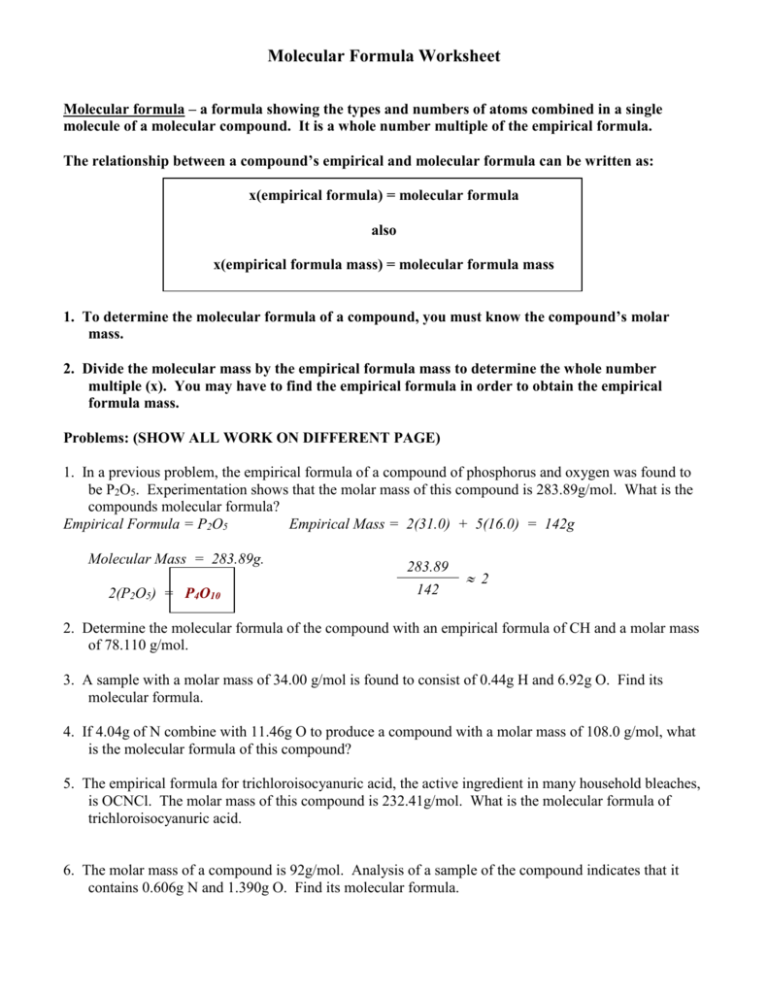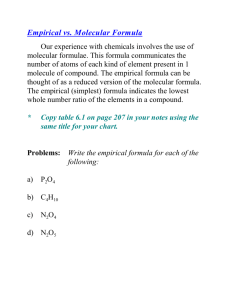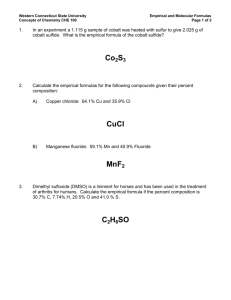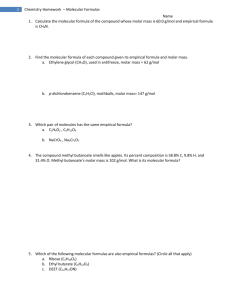Molecular Formula Worksheet
advertisement

Molecular Formula Worksheet Molecular formula – a formula showing the types and numbers of atoms combined in a single molecule of a molecular compound. It is a whole number multiple of the empirical formula. The relationship between a compound’s empirical and molecular formula can be written as: x(empirical formula) = molecular formula also x(empirical formula mass) = molecular formula mass 1. To determine the molecular formula of a compound, you must know the compound’s molar mass. 2. Divide the molecular mass by the empirical formula mass to determine the whole number multiple (x). You may have to find the empirical formula in order to obtain the empirical formula mass. Problems: (SHOW ALL WORK ON DIFFERENT PAGE) 1. In a previous problem, the empirical formula of a compound of phosphorus and oxygen was found to be P2O5. Experimentation shows that the molar mass of this compound is 283.89g/mol. What is the compounds molecular formula? Empirical Formula = P2O5 Empirical Mass = 2(31.0) + 5(16.0) = 142g Molecular Mass = 283.89g. 2(P2O5) = P4O10 283.89 142 2 2. Determine the molecular formula of the compound with an empirical formula of CH and a molar mass of 78.110 g/mol. 3. A sample with a molar mass of 34.00 g/mol is found to consist of 0.44g H and 6.92g O. Find its molecular formula. 4. If 4.04g of N combine with 11.46g O to produce a compound with a molar mass of 108.0 g/mol, what is the molecular formula of this compound? 5. The empirical formula for trichloroisocyanuric acid, the active ingredient in many household bleaches, is OCNCl. The molar mass of this compound is 232.41g/mol. What is the molecular formula of trichloroisocyanuric acid. 6. The molar mass of a compound is 92g/mol. Analysis of a sample of the compound indicates that it contains 0.606g N and 1.390g O. Find its molecular formula. Molecular Formula Worksheet 1. Empirical Formula = P2O5 Empirical Mass = 2(31.0) + 5(16.0) = 142g Molecular Mass = 283.89g. 283.89 2 142 2(P2O5) = P4O10 2. Empirical Formula = CH Empirical Mass = 1(12.0) + 1(1.0) = 13g Molecular Mass = 78.110 amu 6(CH) = 78.110 6 13 C6H6 3. 0.44g H 6.92g O 1 mol H 1.0g H 1 mol O 16.0g O = 0.44 mol H 0.44 0.433 =1H = 0.433 mol O 0.433 0.433 =1O HO Empirical Formula = HO Empirical Mass = 1(1.0) + 1(16.0) = 17g Molecular Mass = 34.00 amu 2(HO) = H2O2 34.00 17 2 4. 4.04 N 1 mol N 14.0g N = 0.289 mol N 0.289 0.289 =1N X’s 2 11.46g O 1 mol O 16.0g O = 0.7163 mol O 0.7163 0.289 = 2.5 O Molecular Formula Worksheet N2O5 Empirical Formula = N2O5 Empirical Mass = 2(14.0) + 5(16.0) = 108.0g Molecular Mass = 108.0 amu 1(N2O5) = 108.0 108.0 N2O5 5. Empirical Formula = OCNCl Empirical Mass = 16.0+12.0+14.0+35.5 = 77.5g Molecular Mass = 232.41 amu 3(OCNCl) = = 1 232.41 3 77.5 O3C3N3Cl3 6. 0.606g N 1.390g O 1 mol N 14.0g N 1 mol O 16.0g O = 0.0433 mol N 0.0433 0.0433 =1N = 0.08688 mol O 0.08688 0.0433 =2O NO2 Empirical Formula = NO2 Molecular Mass = 92 g 1(NO2) = N2O4 Empirical Mass = 1(14.0) + 2(16.0) = 46.0g 92 46 = 2








